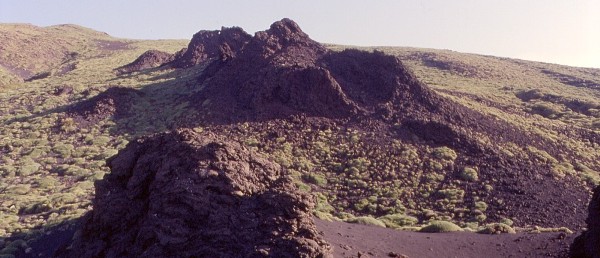| Etna
index |
||
| Geology | Geological history | Cones and craters |
| Eruptive characteristics | Eruptions before 1971 | Eruptions since 1971 |
| Etna and Man | References | Web sites |
| Weather forecasts | FAQ | Latest news |
 |
The
1634-1638 eruption was the second longest flank eruption of the
17th century and emitted about 150 million cubic meters of lava.
But differently from several other eruptions during that century
(such as the 1646-1647 Monte Nero
and the 1669 Monti Rossi eruptions),
this was a virtually non-explosive event. Explosive activity was
limited to mild spattering at the eruptive vents, leading to the
growth of a row of peculiar little cones consisting of welded
bombs and spatter. This image, taken on 24 May 1998, shows several
of these cones in the central portion of the 1634-1638 eruptive
fissure, looking upslope toward the Schiena dell'Asino (the south
rim of the Valle del Bove) |
Mamma
Etna's countless children
1634-1638 eruptive vents
SSE flank, 15.021884° E, 37.706197° N
Summit elevation: 2070-2000 m
![]()
While
many flank eruptions of Mount Etna produce sizeable pyroclastic cones
(the result of strong explosive activity), others have very low degrees
of explosivity and no pyroclastic cones of appreciable dimensions are
formed. But even these low-explosivity eruptions can produce huge amounts
of lava, as was impressively shown during the 1991-1993 eruption in the
Valle del Bove. During their initial stages, mild degassing at the eruptive
vents produces small bursts of liquid spatter that fall down immediately
next to the vents and build small edifices that are generally known as
hornitos (the Spanish word for "little ovens") or spatter cones.
A spectacular row of spatter cones was built at the eruptive fissure of
a voluminous eruption that occurred on the SSE flank of Etna in 1634-1638,
on the southern outer slope of the Valle del Bove. These are still very
well preserved, and a footpath leading up to the rim of the Valle del
Bove passes nearby. There are about 15 distinct spatter cones of different
size and shape, ranging from very small mounds about 1 m high to broad
rings of agglutinated (welded) spatter with diameters of up to 10 m and
heights of 5-8 m.
I visited the 1634-1638 vents first on the early morning of 24 May 1998
and returned to the place in September 1999. The photos on this page were
taken during these two visits.
Copyright © Boris Behncke, "Italy's Volcanoes: The Cradle of Volcanology"
Page set up on 12 March 2004
